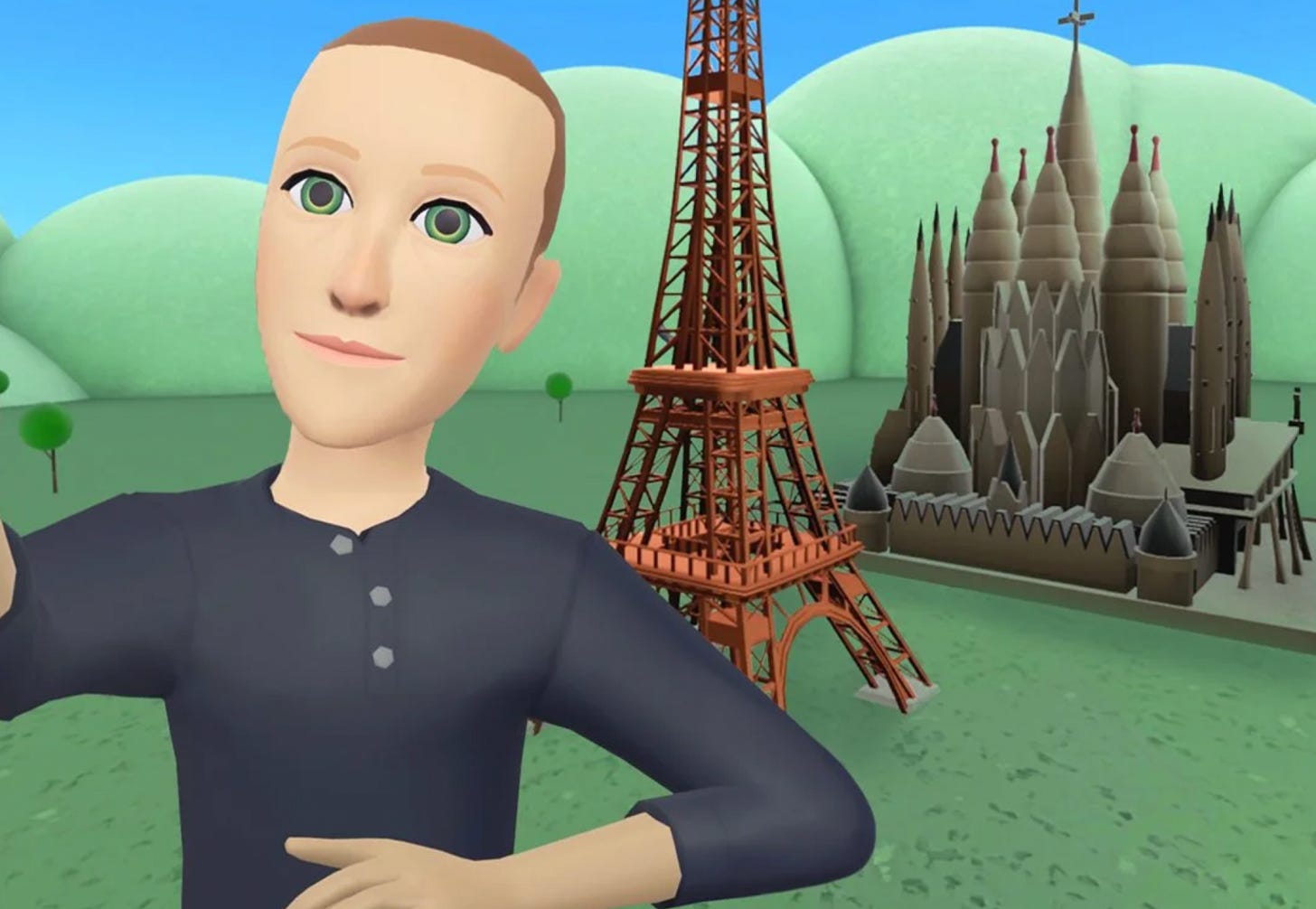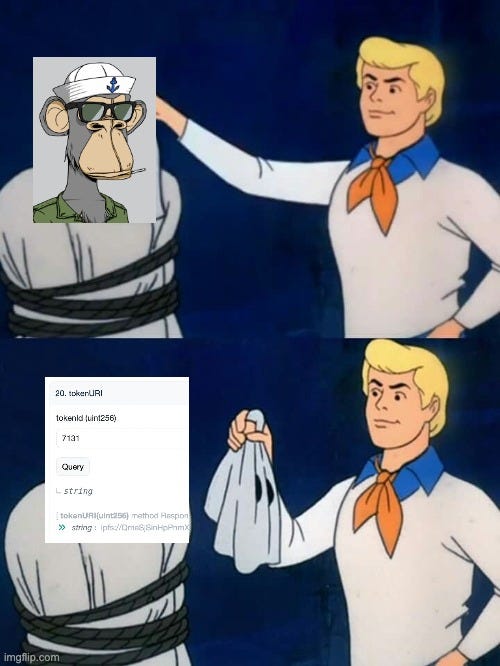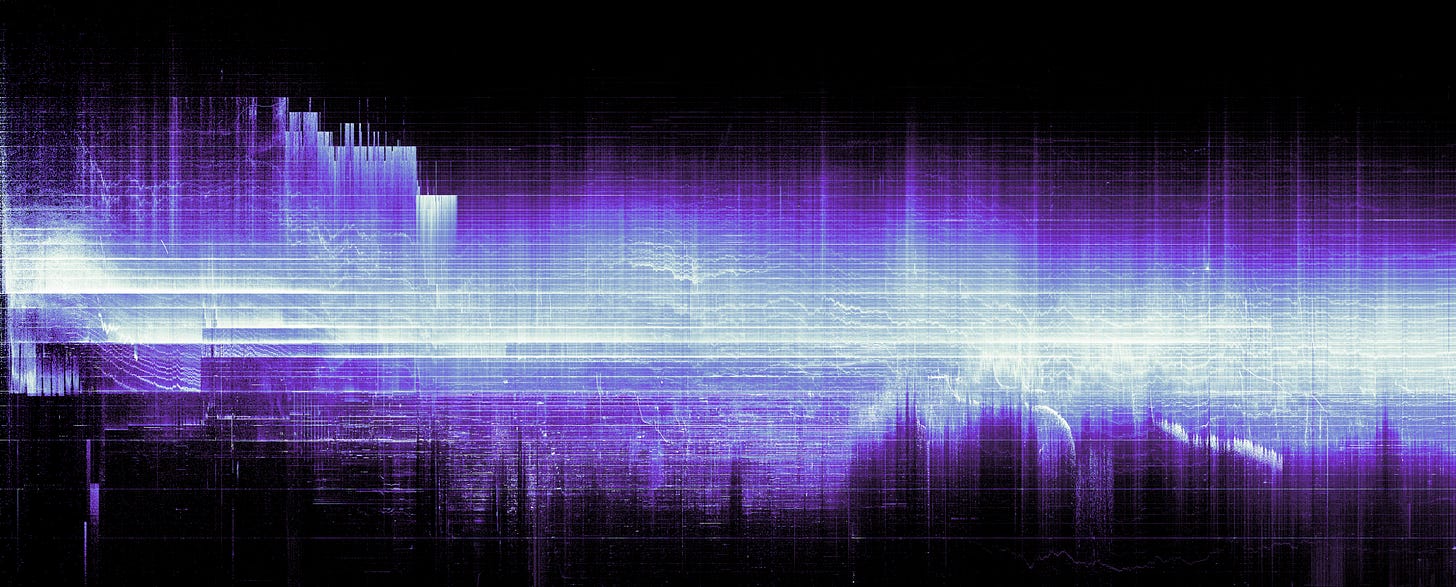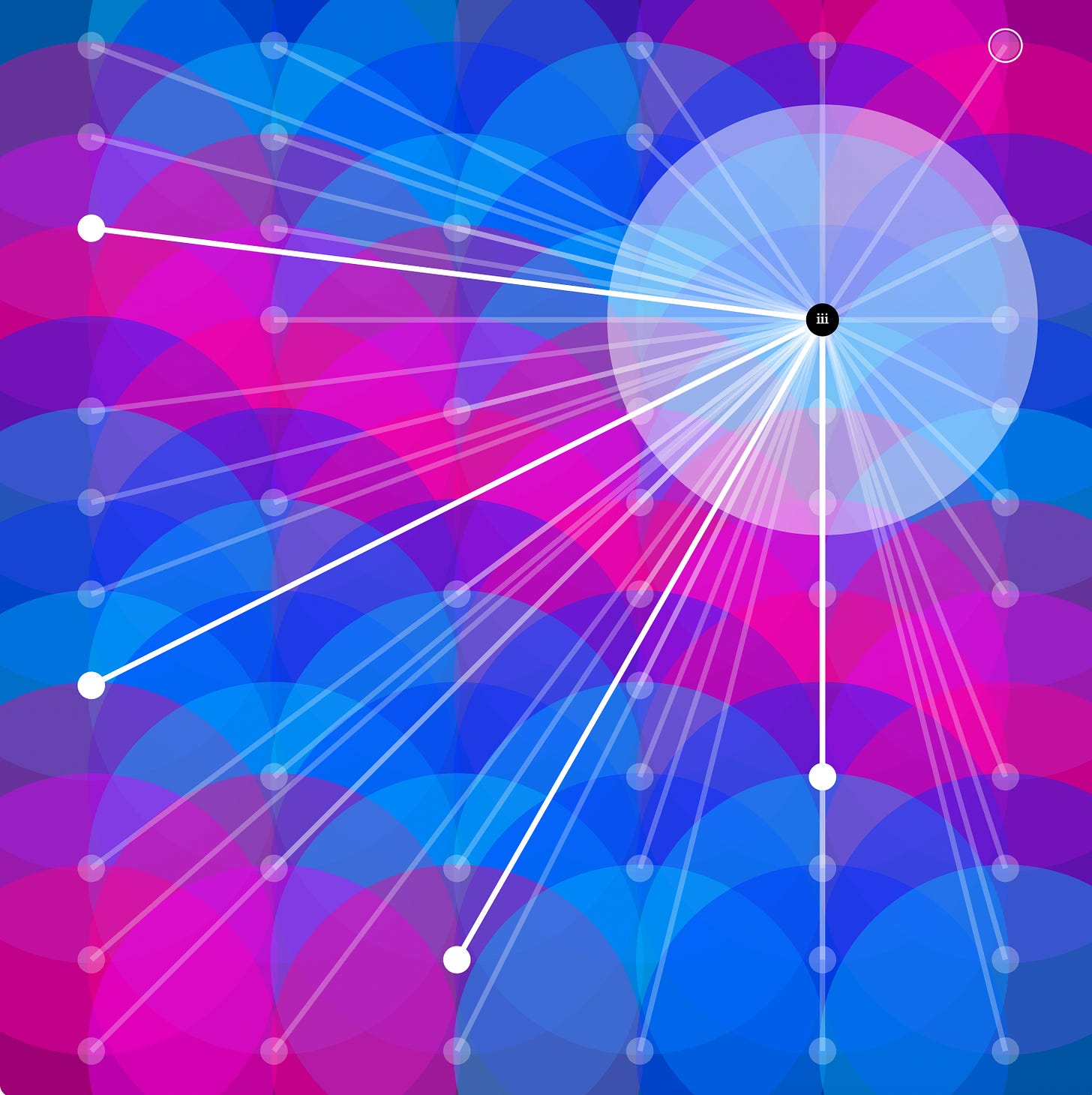NFTs Can't Die
The Past and Future in the Present. Also: Fake Steakhouses, The WGA Deal, and more Ambient Music
NFTs are dead. Again. Rolling Stones said so. Never mind that its methodology might be a bit questionable.
Regardless. Volume is down. Companies are shuttering and pivoting.
For many, it’s a rejoice at seeing an industry that grifted, scammed, and fleeced collectors, many with the promise of getting rich along the way, finally, and seemingly die. Good riddance as Ed Zitron proclaims:
The NFT hype was a long con on customers and the media at large — a classic scam where companies built the appearance of value without ever actually generating any. And it worked, enriching already-wealthy people like Marc Andreessen and Alexis Ohanian and conning retail investors for profit.
The noise has now died down, the zoo departing from the online cities.
Yes, there were scammers. Yes, much of the industry that grew into mainstream awareness were filled with unlikeable people that only stayed around when the going went well. I do not disagree with that. In the very-online cabin fever of 2020-2021, even Mark Zuckerberg believed that the days of touch grass was over.
The hyperreal of the cyberspace and the blockchain were to represent reality. The canvas would be a “digitally scarce” jpeg, not dead trees.
And then… we went outside again, interest rates rose, and behind the masked veil was a right-click save. Underneath it all was a token. A link to a URL?! A boogeyman scam.
So, phew, it’s all over isn’t it?
Not really, you see. NFTs can’t die. And that’s why a lot of people missed the point.
A blockchain records it all. You can see it through many lenses.
From inception, here’s all the plotted ETH transfers over time. y=amount of ETH. x=time. A heatmap by banteg.
Or. Here’s a rendering of white signing wallets interacting with multi-signature wallets (colored boxes). Created by Takens Theorem.
So, yes, behind the monkey jpg was a token. But, that token is a slot of memory across time, its own history etched into its existence, recording transfers and interactions between all speculators, hypebros, true supporters, enjoyooors, sincere collectors, and others. Its story would grow from its onchain activity as well the life it took on outside of it. A right-click save merely added to it. And creating a new exact token with the same image would only serve to further entrench the meaning of the original: imprinted into the ledger was a new story, the indelible existence of a print, a facsimile, a recreation.
For 95% of these 2021 NFTs, their links will decay, turned into rot, and eventually become lost under the detritus of the rest of our zeitgeist. What will be left is only their history: fossilized rings in a merkle tree that tells about the seasons of yesteryear. On even longer timelines, the tokens which once had a face will have fully lost its shine, compacted into layers of cryptographic earth for a future web archaeologist to decipher. Looking closer, just what the hell was 0xCryptoAhYeah.eth doing trading a Lazy Armadillo Gang NFT for a CryptoDickButt? Who were they? Who did they become? Like imagining feathers on a dinosaur, we would see depictions of what a Lazy Armadillo Gang NFT would’ve looked like. And ten years after that transaction, they bridged their dormant ETH to a layer 2 chain and never brought it back. Their story had ended.
This reality, that NFTs can’t die has always formed a fundamental disconnect. It encompasses why many were confused at the same time that others see a truly interesting technology.
Most databases are snapshots, but blockchains have history. When you see an NFT as having history associated with it, then you understand why a right-click-save only serves to add to its ongoing story. From the other lens, seeing an NFT as only a snapshot, you miss why much of this technology is important as a medium for information: not just in terms of art, collectibles, and new forms of finance.
This era will be marked as the first skeuomorphic era of the medium. What was made, was simulacra of the real world. Objects in the real world don’t bring their history along with it, so why would we think otherwise? For objects in the real world, their history is kept in stories that disappear as fast as the flicker of the flame its told over. If you are lucky, it would be captured in notes/documents/pictures/songs, and in the art world, perhaps a full paper archive.
And so, those who made this era of NFTs, built them with the implicit assumption that each one’s history was understood. If need be, you’d be willing to navigate the immutable ledger that gave it meaning by literally looking at esoteric cryptographic incantations. A blockchain explorer full of signatures, transactions, headers, nodes, wallets, acronyms, merkle trees, and virtual machines.
On top of this, most of the terminology today still points to seeing it all as a market and a speculative game. And so, I understand why the rest was missed. The primary gallery for most people, was a marketplace. A cryptographic key to write with is called a wallet. Gas paid is used as ink to inscribe. All expression with this shared ledger is one of the reduction of humanity to prices. It’s thus understandable and regrettable that the way this was shown, wasn’t to show its history, but to proclaim it’s financialness as its prime feature. The blockchain after all only exists because people are willing to spend resources to be more certain about the future. It is birthed in moneyness. Alongside those who saw a record-keeping machine, it would attract the worst kind of people, those whose only meaning comes from prices. For this story to keep being told, its narratives have to change.
The next era, will hopefully thus, be marked as a recontextualisation to make apparent that this medium is buffeted by context and provenance. Within this machine that irrevocably trudges along into the future, it will continue to collect more context. A gravity well of us. Just as we have the freedom of information on the web, spilling out tales of horror and utter goodness, so too does a blockchain.
Just what does such a recontextualization look like? It’s surfacing its stories alongside adding new visions of the medium as one of history and provenance. A token is a vessel carrying stories within (perhaps, a boat story too).
For example:
Receipt by 0xHaiku makes this explicit. Each transfer is displayed on the artwork itself. The artwork isn’t linked to some server, it’s stored in the artwork itself, onchain.
Mesh by Takens Theorem is an art piece and collection that is aware of the rest of its shared context. Other holders and their collections changes your piece, dynamically over time.
Or with a project of mine, Witness The Draft, taking inspiration from The Mesh, it allows artworks to witness each other, recording the social interplay between them.
Once we realise that history is in each NFT and knowing that it can’t die, we will envision what this medium will do for the future.
Exodus II by Folia and David Rudnick enshrines the sale of poems into the future, the last one being 37 years into the future.
With 0xDeafbeef’s Noumenons and Chronophotographs, he asks us to consider how we record snapshots across time.
On a time locked schedule, a blockchain transaction can be triggered to metaphorically "capture" an observation of a Noumenon, minting a new ERC721 token in this companion series. The blocknumber serves as the seed for a deterministic program to generate an image in the style of Muybridge's chronophotographs, representing the attempt to transcend sensory limitations through the use of technology.
Viewers are encouraged to reflect on the perception of time, consensus reality, photography and blockchain as sources of objective truth, limitations thereof.
With my “This Artwork Is Always On Sale”, an artwork with a unique built-in property rights system, will forever be on sale as long as the Ethereum blockchain exists. When I’m long gone, it will still be able to bought and sold.
The reality is. These experiments and artists that take into consideration the availability of the provenance and the understanding of how it will change into the future has always been here.
In 2014, Rhea Myers created “This Is Art”.
“Is Art” is an Ethereum contract that can be instructed to nominate itself as art (or not). Whoever toggles the contract’s state as art sets it unimpeded until the next person sends a transaction to change it.
In it, an Ethereum smart contract contains the assertion that it either “is” or “is not” art. A web page connected to the Ethereum network displays the state of this assertion to anyone who can access the contract and allows them switch it between states. When they do so this will become a fact secured in Ethereum’s blockchain with the strength of millions of dollars of computing power a day.
Or, in 2017, Mitchell F. Chan, when inspired by Yves Klein’s conceptual work, created Digital Zones of Immaterial Pictorial Sensibility.
The Digital Zones tell a story about how different concepts of ownership are fundamental to the experience of an artwork. The artwork--and the 33-page essay which accompanied it--speculated that if, at some point in the future, artworks were owned and transacted through immaterial blockchain tokens, that shift in the commodity form of the artwork could also precipitate a shift in the material (or immaterial form) of the artwork.
These are just a handful of examples.
What’s more is that ALL NFTs currently have histories in them, but few of them are a part of the experience. Besides explicit conceptual work, I don’t know what this would look like for the broader set of artworks and collectibles.
It could be like Zora, where “mint with comment” records conversations and surfaces it on a UI that’s not a marketplace.
Or, like Receipt, where its context is in the artwork itself. I leave this up to the artists and designers to figure out.
Thus, what has died is what should’ve died. Many grifters, scammers, and the people who only saw this as an investment and as a form of speculation. Unfortunately, and regrettably, this includes people who were swept up, hoping to make a quick buck, only to lose life savings along the way.
Much like the internet, 95% of it doesn’t pertain to you. But, on some days, the rest of it can be quite loud, drowning out the corner you’ve created for yourself. What makes a blockchain ledger as a social space unique and difficult is that because everyone shares its history, it can amount to thousands of people shouting at each other in a crowded room. You’re never far away from what’s happening around you. Your conceptual art piece is collected in the same block as the hacker who just phished a person who was hoping to pay rent with that money. For a misanthrope, it can be hell, but for someone interested in seeing humanity in all its forms, there’s nothing quite like it. If context is everything, then a blockchain is all of everything, everywhere, all at once. The past and the future is in the room with us right now.
The real challenge is how to tune the noise to the frequencies you care about. Perhaps that’s ultimately impossible and that for most it will always remain a cacophony of “monkeys”. Still, if we expect this to outlast most of us, then there is time. What we build with a shared ledger that extends into the past and the future is up to us.
NFTs might dead for now, but they can’t really die.
More Links!
Phew. Sorry. Much bigger post than I expected. 😅
Mehran’s “Fake” Steakhouse
This is a really great story. A fake Google Maps listing turned into a real, exclusive one-night-only Upper East Side steakhouse.
This story is probably a decent Rorschach test for how you feel about fine dining. On one hand, you might see that: “Look. It’s all fake. People commenting on how the minimalist aesthetic complimented the food. It’s elitist!”
For me, it’s just a really great example of how the stories we tell about food is as much a part of the experience. Food does not exist in a vacuum. Even though its origins are not as one would expect, having a great evening or not is a part of our expectations. It doesn’t matter really whether it’s fake or not.
WGA Deal
The WGA signed a deal with AMPTP. Almost 150 days later, it’s done and the writers are back at work. It generally looks like a pretty decent deal, tbh. The most important part for me, is seeing that writers actually get decent residuals and bonuses for writing a successful show.
As for the AI component.
AI can’t write or rewrite literary material, and AI-generated material will not be considered source material under the MBA, meaning that AI-generated material can’t be used to undermine a writer’s credit or separated rights.
A writer can choose to use AI when performing writing services, if the company consents and provided that the writer follows applicable company policies, but the company can’t require the writer to use AI software (e.g., ChatGPT) when performing writing services.
The Company must disclose to the writer if any materials given to the writer have been generated by AI or incorporate AI-generated material.
The WGA reserves the right to assert that exploitation of writers’ material to train AI is prohibited by MBA or other law.
I’m generally in favour of the above. In this case, AI is seen as a tool that requires human authorship and guidance. Admittedly, it still leaves me a bit confused in general about when/where authorship is relevant. It feels like the assumption here is that a studio might spit out a full script with one prompt and then just pass it onto a writer. But, the reality is that it will probably become increasingly complicated. In visual arts, for example, adding a generative in-fill with photoshop is more complicated than a pure prompt-only approach. I won’t be surprised if studios eventually want to draw this line more explicitly.
Regardless of how/where copyright is applied, the credits in the contracts are adjusted away from AI usage on the company side. Obviously a smart move on part of the WGA to not wade too deeply into rights issues, hence why they said, they reserve the right to claim that it’s not fair use to use existing material to train a model. I think, regardless of the eventual court opinions or law surrounding when/where copyright is actually applied, this is substantially more pro-writer than giving the studios additional leverage. This is also a win, regardless of whether you think that allowing companies to produce AI written scripts will be good or not (I still think they won’t really be that good or even if it’s good, not as many people will care compared to more human intent behind production). You can’t automate authenticity.
This will remain an interesting trend to follow regardless of whether you believe it will matter or not.
What are your thoughts on the deal?
A Blog Post as Search Query
I enjoyed this essay on how writing online is in part a way to connect to you. I write for many reasons, but in part, it’s also because I want to find people who care about all of this as much as I do. By Henrik Karlsson .
The opening paragraph resonates. I’m also a 89 baby.
I was born in July 1989, which means I am of the last generation who will remember the time before the internet. The cables and data centers and hyperlinks grew up around me; they grew with me. I find it hard to disentangle the evolution of my psyche from that of the internet.
Growing up in South Africa meant it was also a few years behind. I only got broadband internet access when I was 18. So my childhood was filled with calling the homes of my friends, hoping they are around and wanting to catch up, to growing up in phpbb forums online, lagging through 56kb modems in online games, and eventually finding MySpace to the online social media-sphere.
What I sometimes struggle with, in assessing my own moods and the moods of the world, is that I don’t whether my feeling stems from how and when I grew up and where I am now. Is my desire for touch grass universal, or is it just because I’m in my early 30’s? Is it because I also remember the pre-internet and what it felt like? Who knows.
How do you feel?
Weekly Zora Mint
This week’s weekly Zora mint is from Rangga Purnama Aji, a visual artist and musician. It’s an interactive, moving piece, so you have to click through to see it in action!
He also does live music coding, which is also fascinating to watch and listen to!
The weekly Zora mint also contains a referral link. If you mint this, I will earn referral fees.
Casino Versus Japan - Come Along, Do
Gosh, I can’t get enough of Casino Versus Japan. I’m slowly working my way through his discography again, rediscovering great ambient tracks. I always find it interesting how when you go back to something you listened to in the past, how it can find new meaning and emotions. The music hasn’t changed, but you did.
That’s it for this week, friends.
Enjoy a sunset!
Simon


















Really good article!
Massive cope